A History of Thanksgiving: From George Washington to Franklin Roosevelt
When you finish reading this the third and last in my series on A History of Thanksgiving, enjoy these videos with slideshows of the historic images accompanied by music.
Just before leaving for a recess, the first U.S. Congress passed a resolution asking President George Washington to recommend a day of Thanksgiving. A few days later, President Washington issued a “Day of Publick Thanksgiving” for Thursday, November 26, 1789. He declared a day of Thanksgiving again in 1795. Presidents John Adams and James Madison also issued Thanksgiving proclamations twice each in their presidencies. Other presidents also issued Thanksgiving proclamations but the dates varied, and sometimes even the months.
In 1802, Lydia Maria Francis was born in Medford, Massachusetts, the fourth oldest English settlement in the United States and one of the towns Paul Revere rode through when he announced that the British were coming. Maria was taught at home, at a dame school, and at a women’s seminary.
Maria wrote the novel Hobomok and founded a children’s magazine called Juvenile Miscellany. She later married David Lee Child and continued to earn her living as an author. One of the books she wrote was The Frugal Housewife, an advice book for women. David and Maria worked hard in the abolitionist movement. Lydia Maria Child also worked for women’s suffrage.
In 1844 Child published Flowers for Children, which included:
A Boy’s Thanksgiving Day
Over the river and through the wood,
To Grandfather’s house we go.
The horse knows the way to carry the sleigh
Through the white and drifted snow.
Over the river and through the wood —
Oh, how the wind does blow!
It stings the toes and bites the nose,
As over the ground we go.
Over the river and through the wood,
To have a first-rate play.
Hear the bells ring, “Ting-a-ling-ding!”
Hurrah for Thanksgiving Day!
Over the river and through the wood
Trot fast, my dapple-gray!
Spring over the ground, like a hunting hound!
For this is Thanksgiving Day.
Over the river and through the wood,
And straight through the barn yard gate.
We seem to go extremely slow,
It is so hard to wait!
Over the river and through the wood —
Now Grandmother’s cap I spy!
Hurrah for the fun! Is the pudding done?
Hurrah for the pumpkin pie!
Though Thanksgiving was not a national holiday during the early 1800s, Americans continued to celebrate the feast, mainly in New England. There each state declared an annual Thanksgiving, usually in November. As New Englanders moved west, they carried the Thanksgiving tradition with them. Other states began to celebrate it, too. The Southern states were the last to adopt the practice that they at first considered a Yankee holiday.
Louis Antoine Godey co-founded Lady’s Book in 1830 in Philadelphia, Pennsylvania. It was the first American magazine entirely devoted to articles of special interest to women. He later became its only owner and it became Godey’s Lady’s Book. Sarah Josepha Hale served as its editor for several decades. Each November from 1846 to 1863, she wrote editorials urging the United States government to declare Thanksgiving a national holiday. Abraham Lincoln declared the last Thursday in November to be Thanksgiving Day in 1863. Afterwards, each president followed his example. Between 1863 and 1938, the last Thursday in November was Thanksgiving every year except for two.
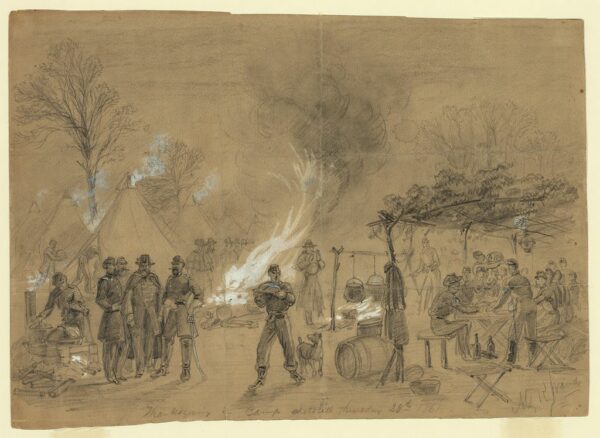
Thanksgiving in Camp, sketched November 28, 1861,
by artist Alfred R. Waud. Courtesy of the Library of Congress.

Home to Thanksgiving by George H. Durrie,
published by Currier and Ives, c. 1867.
Courtesy of the Library of Congress.
James, John, Joseph, and Fletcher Harper were publishers during the 1800s. Harper and Brothers began publishing magazines, such as Harper’s New Monthly Magazine (1850), Harper’s Weekly (1857), and Harper’s Bazar (1867, William Randolph Hearst later bought this periodical and added another “a” to Bazar). Harper’s Weekly helped readers consider the plight of immigrants.
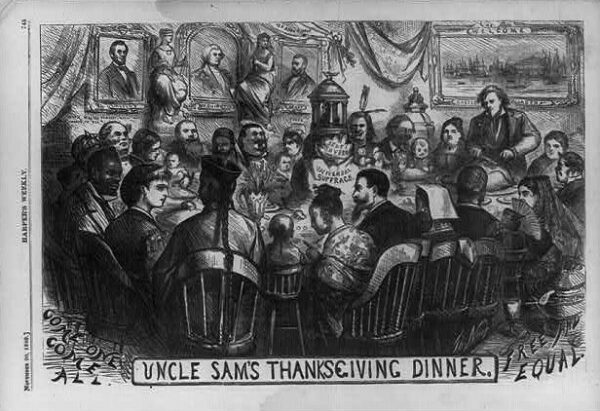
In this illustration from the November 20, 1869, issue of Harper’s Weekly,
Uncle Sam carves a turkey at a large table surrounded
by men, women and children of different ethnicities.
The centerpiece has this label: Self-government/Universal suffrage.
Courtesy of the Library of Congress.
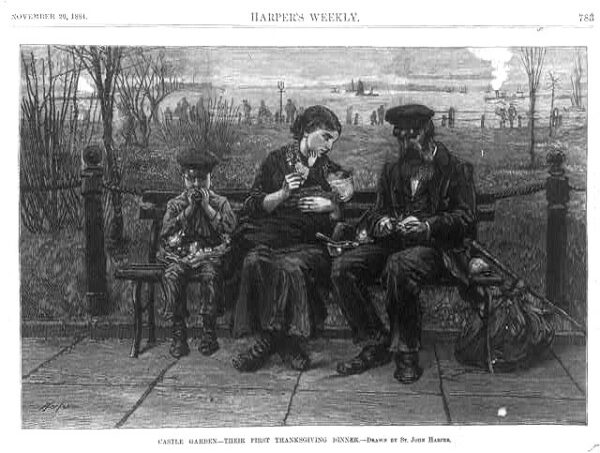
This illustration from the November 29, 1884
issue of Harper’s Weekly is entitled,
“Castle Garden — Their First Thanksgiving Dinner.”
Castle Garden was the first stop for immigrants
coming into New York City before Ellis Island
was built in 1892. Courtesy of the Library of Congress.
At least by the late 1800s, public schools were teaching children about the Pilgrims and their celebration with members of native nations in 1621.

Thanksgiving Day lesson at Whittier
by Frances Benjamin Johnson, c. 1900.
Courtesy of the Library of Congress.
At least by 1911, children were dressing up to represent Pilgrims.
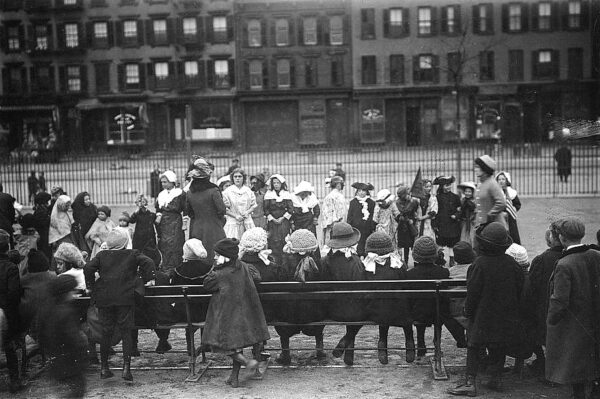
“School Children’s Thanksgiving Games,” November 27, 1919.
Courtesy of the George Grantham Bain Collection
in the Library of Congress.
In 1939 the last Thursday in November was on November 30. Merchants asked President Franklin Roosevelt to change the date so that the Christmas shopping season would be longer. President Franklin Roosevelt declared Thanksgiving to be the next to last Thursday in November. The date change caused an uproar and some people began to call the holiday “Franksgiving.” President Roosevelt admitted his mistake. In 1941 the U.S. Congress passed a joint resolution declaring the fourth Thursday in November to be the official federal Thanksgiving Day. President Roosevelt signed the resolution on December 26, 1941.
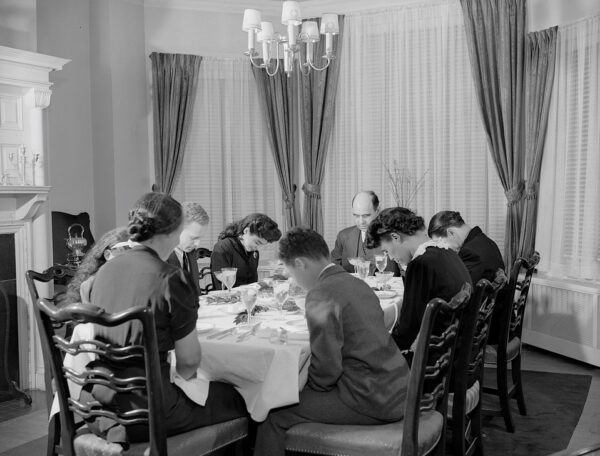
Dr. Mordecai Wyatt Johnson, first black president
of Howard University, says grace before Thanksgiving dinner
in November 1942. Photo by Gordon Parks.
Courtesy of the Library of Congress.
How blessed we are to live in a country with an official day of Thanksgiving. It’s up to us to teach our children to have hearts of thanksgiving every day.
Enter His gates with thanksgiving
And His courts with praise.
Give thanks to Him, bless His name.
For the LORD is good;
His lovingkindness is everlasting
And His faithfulness to all generations.
Psalm 100:4-5
Here’s that link to videos with slideshows of the historic images accompanied by music.

